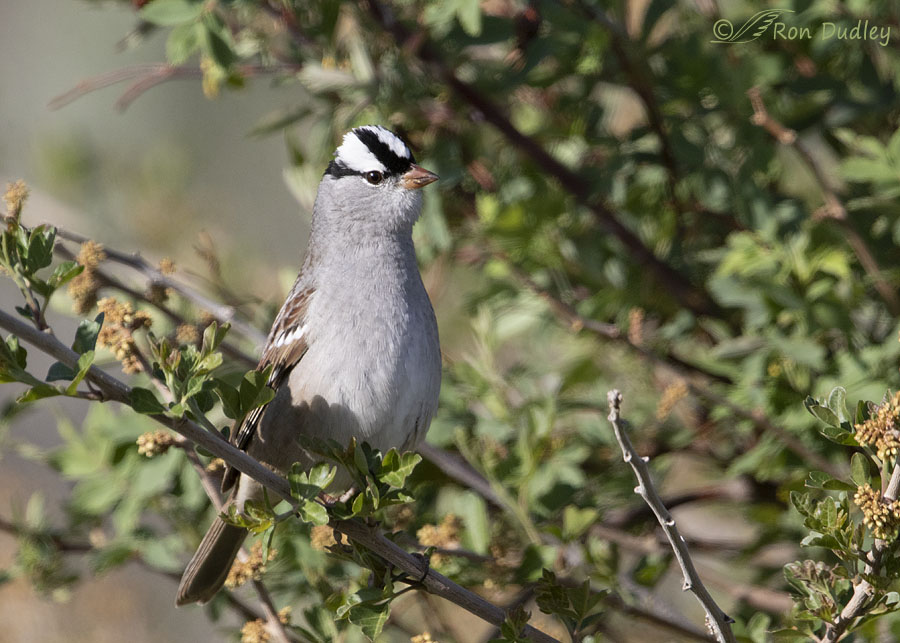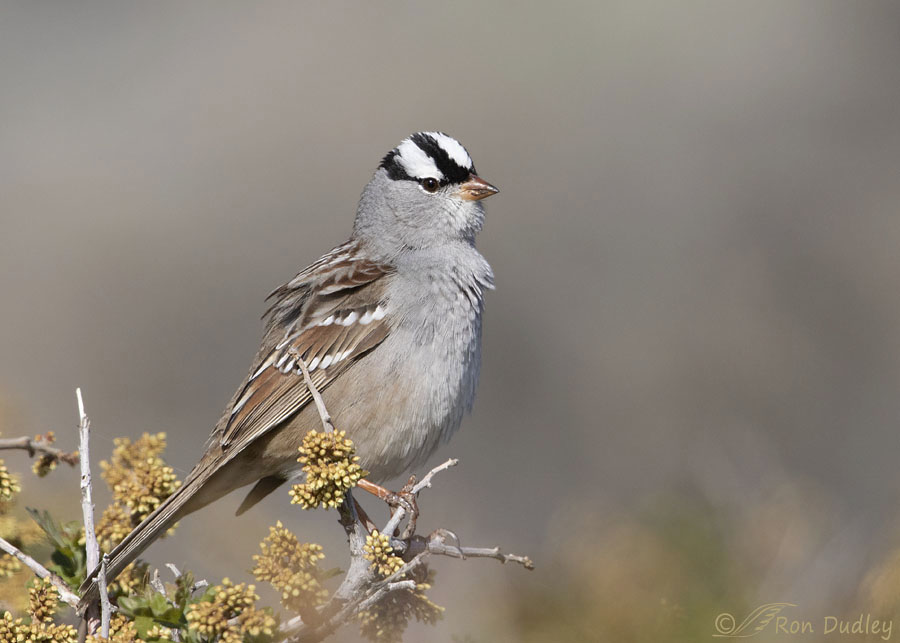A feeding behavior I was unaware of in this species. I should have been.
Two days ago I posted photos of a Yellow-rumped Warbler hawking insects from a sumac bush that were taken the day before I posted them. The White-crowned Sparrow below was doing the same thing from the same bush on the same morning. In fact the photos of the two birds were taken less than one minute apart.
- “Hawking is a feeding strategy in birds involving catching flying insects in the air. The term usually refers to a technique of sallying out from a perch to snatch an insect and then returning to the same or a different perch.”
Hawking, especially when the insect quarry is tiny, is most often practiced by smaller songbirds that weigh very little so they’re extremely agile in flight. Speed and agility in flight are obvious and huge advantages for catching small insects in the air. Various warbler species who tend to be quite small are excellent hawkers, including Yellow-rumped Warblers who weigh only about 12 grams.

1/2500, f/6.3, ISO 640, Canon 7D Mark II, Canon EF 500mm f/4L IS II USM + EF 1.4 III Extender, not baited, set up or called in
But this White-crowned Sparrow weighing significantly more than twice as much as a Yellow-rumped Warbler (29+ grams) was hawking tiny insects repeatedly and successfully. I never caught him in a photo as he was taking off after an insect like I did the warbler but here we see “him” stretching out just about as long as he could stretch in order to see insects in flight over sumac branches out of frame to our right.
This was the first time I remember seeing White-crowned Sparrows hawking insects. I strongly suspect I’ve seen it before, possibly many times, but either I didn’t notice or it just didn’t register. It’s certainly a known behavior in the species – this from Cornell’s Birds of the World about White-crowned Sparrows:
- “Takes seeds and arthropods (insects) from soil surface and from plants, and hawks insects from perch.”

1/4000, f/6.3, ISO 640, Canon 7D Mark II, Canon EF 500mm f/4L IS II USM + EF 1.4 III Extender, not baited, set up or called in
Almost immediately after the previous photo was taken the sparrow flew to another nearby part of the sumac and resumed hawking from his new perch.
I take this observation as evidence that I need to pay more and better attention in the field. Almost certainly I’ve seen White-crowned Sparrows hawking insects before so why didn’t it register? I suspect it might be because I’m too often preoccupied with the photography challenges of the moment at the expense of bird behaviors.
Obviously I need to improve my multitasking skills.
Ron
PS – I certainly don’t mean to suggest that only the smallest of songbirds hawk insects. There are far too many variables involved, including size and speed of the insect quarry, for that to be true. The tyrant flycatcher family, Tyrannidae, is evidence of that. Many of the flycatchers are almost as large or even larger than White-crowned Sparrows and they’re so skilled at hawking insects they’re actually named after the behavior.


Love the shots. White Crowns left our area last month. One of my favorite Sparrows.
Thanks, Jean.
I knew that many small birds did snatch their dinner on the run so to speak, but didn’t know that the term for it was hawking. I am grateful to learn but also thinking of the irony in that comment. I suspect that many of the small birds are themselves ‘hawked’.
Multi-tasking? Pfft. I can and do start several tasks at once but whether they get finished and how they get finished is a very different question.
EC, it’s my guess that falconry was the source of the term, given the similarity of a songbird taking off after insect prey in flight to a falconry bird doing the same thing to chase after it’s prey in the air. I dunno though…
Such a handsome fella! He’s so stretched out in the first shot that he makes me think of a penguin more than a sparrow. The poofed up crown is the topper (no pun intended).
There’s a really good ASAP Science video about multitasking that I used to show my students. The more multis one is trying to task, the worse any of them get done.
Marty, I’m just not good at multitasking, never have been and never will be. So I’m going to try to change my approach and say that the single task that I’ll concentrate on while I’m in the field is to improve my multitasking. .Maybe that’ll work…
Beautiful boy! Nice light too. I have been enjoying watching the Lazuli Buntings hawk insects in my yard in the early morning and later afternoon. amazingly agile birds, too fast for my auto focus.
April, there were a couple of male Lazulis at the sumac bush too but neither of them was hawking insects. They were both skulking around inside the bush or on the ground below it. Mostly I just heard them.
In addition to hawking, you have perhaps inadvertently brought to my attention another behavior that I wasn’t previously aware of: I was taken by the large white crown on the White-crowned Sparrow in your photo, so I looked in Sibley to see if it was a geographic variation. Nope. Per Sibley :The crown feather of all sparrows can be raised and lowered at will.”
So double thanks.
I once read that no one really multitasks; some are just faster at alternating from one task to another. And women do it better than men. I can still multitask, only it’s more random these days. At least without a list to follow. If I can remember that I made a list.
“And women do it better than men”
I’m not surprised and it makes perfect sense since women traditionally took on most of the child care duties and homemaking tasks for so many generations, fair or not. Under those circumstances you’d damn well better be good at multitasking.
Reminds me of how frustrated my ex-wife used to get with me because I was so consumed by my “projects”, whatever they might be. When I started a project I stuck to it exclusively until it was finished, at the expense of everything else that needed to be done. I’m still that way. Diane used to HATE my projects…
Most interesting! Love the Little-Biker birds as my kids used to call them. I haven’t noticed the white crowned sparrows doing this but as you said the warblers. I watched about 6 yellow-rumped warblers sitting atop on old stone bridge at twilight flying out hawking insects…such fun for them and me. Amazing how quickly they do it. A few gnat catchers were with them as there was plenty to go around. The White-Crowned have been here for a few weeks…strange they showed up when the White-Throat left. One needs a notebook in addition to camera this time of year!
“One needs a notebook in addition to camera this time of year! ”
Ain’t that the truth. Maybe several of them.
In a way my photos are a type of notebook, so they help me to remember “stuff” I see in the field. Thanks, Kathy.
White-crowned sparrows are near the top of my list of favorites. Their song is so beautiful it can break your heart. I used to see them hawking in Texas where my birds were far closer to my windows and easier to watch. I’ve also seen flocks of sparrows (mostly English sparrows but with others among them) picking Monarch butterflies out of the grills of cars–very sad.
So that begs the question, can/should they be classified as birds of prey?
As for multitasking, I used to (think I could) do it very well, juggling multiple tasks at the same time. Now not so much. Instead, distraction is the way of things, going from one task to the next, never really finishing one before moving forward to the next. Sometimes, even getting to the bathroom is a challenge
Oh, almost forgot…falconer friends were out for a hike around Kingman and saw just-fledged redtails!
“can/should they be classified as birds of prey?”
I’ve often wondered the same thing, Laura. If I had my choice I’d leave such things the way they are but when you think about it it’s lacking in logic.
As of three days ago the nesting red-tails I’ve been watching were still incubating.
Never noticed that behavior with White-Crowned Sparrows, but then there’s a LOT regarding birds I don’t notice until it’s called to my attention! None here yet…… I find multitasking is becoming more difficult and, at times, dangerous as I age!
None here yet…… I find multitasking is becoming more difficult and, at times, dangerous as I age!
” I find multitasking is becoming more difficult and, at times, dangerous as I age!”
Well, that brought a smile of familiarity, Judy. I’m not sure I’m noticing it much yet but I’m sure watching out for it. I guess it’s almost inevitable if we stick around long enough.
Ron, excellent photos, but more important very educational information. Was not aware of the term nor have I paid particular attention while taking photos. Very likely that I have observed the practice on many occasions, but my only interest was in taking the photo and moving on. This little tutorial will definitely change how I observe their actions in the future. Thanks.
PS: One of our bird experts here yesterday posted a rare bird sighting when he spotted a Kentucky Warbler.
“only interest was in taking the photo and moving on.”
Everett, that’s a trap that can be easy to fall into for bird photographers also interested in behaviors. I’m sometimes guilty of it too.
Hello,
I’m more of a reader than a poster, but just wanted to share my own observation of a white throated sparrow (similar size to the white crowned, I believe) doing similar hawking behavior. May 8, 2018 Montrose Point Bird Sanctuary, Chicago, IL. There had been an insect hatch of some sort with insects both in the air as well as on branches, and I followed the sparrow both plucking insects off branches directly as well as leaping into the air briefly to snag an insect once it had cleared the local branch of insects.
Thanks for providing that observation, Tim.
Yes, White-throated are roughly the same size. Sibley says they weigh 26 grams compared to 29 grams for the White-crowned.
Beautiful shots.
We have had a pair of White-crowned Sparrows here for over a week. They usually are here a day or so and continue on. This is the longest this species has stayed put around our area. I’m sure it is due to the cold/snow one day weather we have been having – but, it is awful nice having them around!
Thanks, Dick. For much of the year I see the juveniles much more often but in the spring I see the adults. Which makes sense.